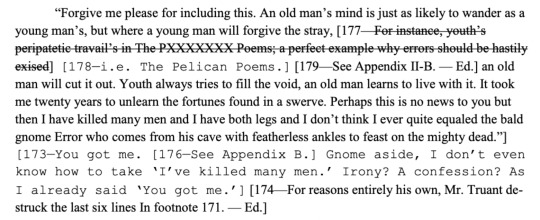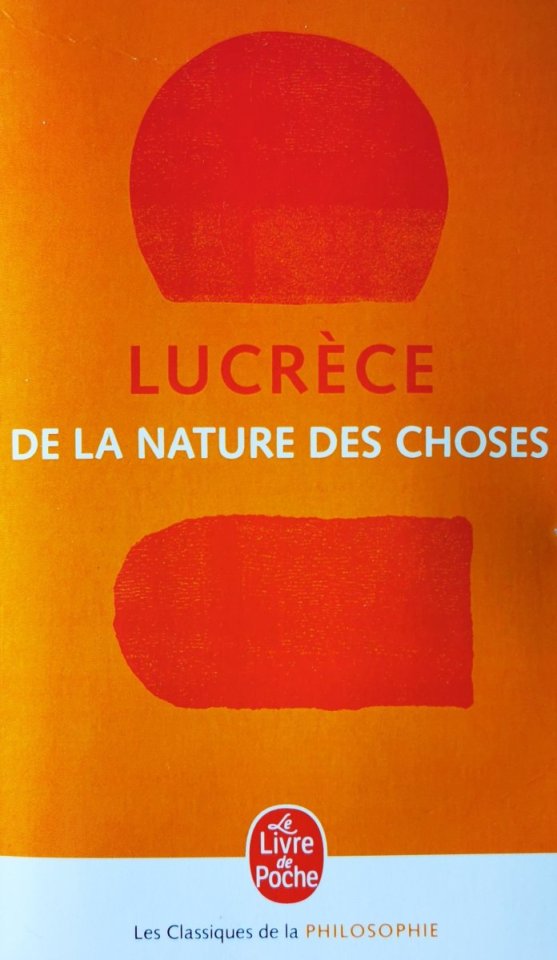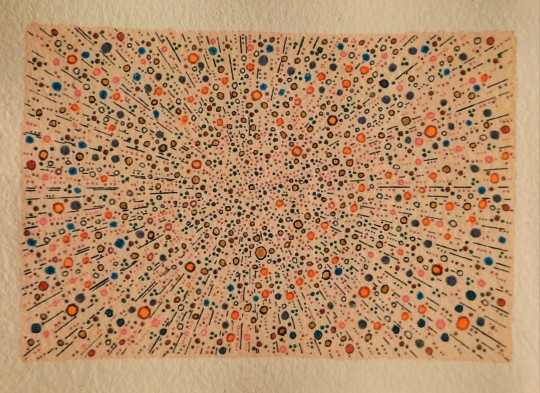#clinamen
Text

"clinamen" | Céleste Boursier-Mougenot, 2013
See the installation and listen to the artist discuss his work here
0 notes
Text
Idolo Hoxhvogli, La comunità dei viventi
da redazione
È uscito da poco per Clinamen il nuovo lavoro del filosofo di origine albanese, Idolo Hoxhvogli: La comunità dei viventi. In questo breve libro tratta del rapporto tra tecnica e trascendenza, teologia e anarchia, viaggio e fermata. La forma utilizzata è quella della prosa breve letteraria, non si tratta di un saggio accademico, come si potrebbe presupporre. Il testo, per come è…

View On WordPress
#italia#leggere#libri#politica#2023#Albania#Clinamen#comunità#filosofia#Idolo Hoxhvogli#racconto#recensione#romanzo
0 notes
Text
Fiche de lecture - Lucrèce, De la nature des choses [De rerum natura] #3
Fiche de lecture - Lucrèce, De la nature des choses [De rerum natura] #3 #Philosophie #MardiCestPhilosophie #Lucrèce #Épicure #Physique #Éthique #Atomes #Clinamen #Âme #Mort
Fiche de lecture n° 45-3
La doctrine et l’œuvre, Chants I-II : Des principes – Chants III-IV : De l’Homme – Chants V-VI : Du Monde
Plan du texte, synthèse et extraits – Du Monde (Chant V-VI)
Note : les nombres, entre parenthèses ou non, indiquent la numération des vers du poème.
Chant V
Prélude
[Ce] fut un dieu, un dieu, le premier qui trouva cette règle de vie à présent dénommée la sagesse…

View On WordPress
#MardiCestPhilosophie#Anima#Animus#Atomes#Épidémie#âme#Biographie#Choses#Citations#Civilisation#Clinamen#désir#De Rerum Natura#Doctrine#Epicure#Esprit#Etna#Evolution#Fiches de lecture#Finalisme#Héraclite#humanité#Immortalité#Incontournables#Infini#Lucrèce#Mardi c&039;est Philosophie#Météores#Météorologie#Monde
0 notes
Text
Amiga culona vecina
IG model getting dicked down
Blond TS doctor Nikki Vicious loves her coworkers thick cock
Romi Rain lesbian fucking
Bluna Surfistinha primeiro anal
Amanda Goulart Comendo Ha Bucetinha Da Amiga
gozando com salto dentro do pau
Brandi Bae does yoga before interracial pussy stretching
Curvy Babe Alycia Starr Enjoys Big Hard Cock
Bumble date fuck
#Ducal#Tirthankara#Kizzie#butt-stock#plexicose#plushy#acetylamine#clinamen#sugar-teat#fizzmodeus#limmata#purchasability#derealization#exogenetic#demonstrableness#showeriness#Gignac#prosecretin#gerontism#kakarot
1 note
·
View note
Text

目に見えぬ詩集, woodblock prints by sara and poems by shuntarou tanikawa
11 notes
·
View notes
Text
was listening to this sugarcane harris record (‘where is my sunshine?’) and it started to skip and I liked it so I let it run for awhile and decided to share
8 notes
·
View notes
Text
“l’imbecillità dei popoli è dato storico costante, l’imbecillità delle élite è fenomeno relativamente recente, peculiarmente tardo-moderno”.
quote from La quotidiana mancanza di F.Bazzani,
via https://opinione.it/cultura/2024/04/02/gustavo-micheletti-la-quotidiana-mancanza-un-libro-malinconico-e-obliquo-fabio-bazzani-editrice-clinamen/
53 notes
·
View notes
Text
youtube
La prevenzione al senso di vuoto la facciamo obbligandoci a pensare al processo di formazione. Il processo di formazione vuol dire: com’è che una vita acquista una forma singolare che la rende viva? Ci sono due modi di pensare la formazione, dovremmo stare attenti a non perdere di vista questa doppiezza. Da una parte c’è l’idea più semplice, la formazione è una scala: ci sono dei gradini, questi gradini sono uno dietro l’altro e descrivono una sequenza di competenze che è necessario acquisire per raggiungere l’ultimo gradino. Non è sbagliata questa rappresentazione della formazione, ma non è sufficiente. Non è sufficiente pensare così perché non avviene quasi mai così, che uno salga la scala dritta teleologicamente dal primo gradino all’ultimo. Ma chi si occupa di formazione sa che la formazione ha un movimento spiraliforme di cadute di fallimenti di sconfitte di riprese di deviazioni ma soprattutto la formazione non è una scala, è un fuoco noi ci formiamo quando siamo scottati da un fuoco. Quando incontriamo qualcosa che ci accende, può essere un maestro un professore un libro un pensiero, è molto spesso l’incontro con il fuoco che rompe la sequenza ordinata degli eventi, introduce delle deviazioni, come dicevano gli antichi dei clinamen degli spostamenti ed è questo che dà alla formazione quel suo tratto singolare. Vi auguro nei vostri inizi di essere un fuoco per qualcuno.
2 notes
·
View notes
Text
Hey, remember the "the bald gnome error" passage from House of Leaves?

(pg. 137 in the print edition)
Well get ready for an analysis post because I FOUND where that came from – The Anxiety of Influence: A Theory of Poetry by Harold Bloom (1973). It's. Quite a Passage:

And so on. To translate (after re-reading this chapter like ten times), Bloom is talking about how in order for a poem to not be derivative/unoriginal, a certain amount of discontinuity needs to be created between a poet's inspiration and their own new work (Bloom calls this process "kenosis"*). Because humans naturally love patterns and order, this is something that usually only happens by accident, through one's mental wanderings ("error" means wander in latin). The god Hermes (i.e., the bald gnome Error) is both the god or travel (and therefore wanderings) and of trade. Poetry is ultimately an economic unit because it "belongs" to the poet. The gory imagery of Error feasting on the mighty dead is a metaphor for the uncomfortable tension of what kind of exchange taking inspiration is. How much can you still call a poem yours when so many of its ideas are scavenged? That's the "anxiety of influence" from the book's title – the artist's fear of being unoriginal.
In terms of House of Leaves, Zampanò (who has just finished the tale of Quesada and Molina) is apologizing for telling a frankly unnecessary story – his mind has wandered, which he knows he should try to avoid. He’s basically saying that the older you get, the more you ought to accept things being left unsaid, but here he’s making an exception. This apology seems to be slightly conflating Bloom’s concepts of Error and Swerve (see footnote). Regardless, saying that he doesn’t think he has “ever quite equaled” Error - at least in my interpretation - is him saying he is never going to exhaust all the potential wanderings he could go on in his book. Perhaps the men he claims to have killed are simply metaphorical, and are the same “mighty dead” (the sources of inspiration) that he’s tried to “feast on" (reference). To reword what he originally said, he's telling us: “I’ve tried very hard to unlearn my tendency for tangents - which probably doesn’t surprising you, but then again, I’ve never been able to go off on as many as I would’ve liked”
So, despite the path to deciphering wtf Zampanò is talking about being somewhat... labyrinthine, it's actually not all that complicated!
*kenosis, or “Error” is different from clinamen, or “Swerve”. Swerve is also a movement away from the original work that inspired the poet, but in a corrective sense - as if the older work was missing something that the new poet identifies and, through his own poetry, points out and perfects
#the real -House- of Leaves experience is doing an incredible amount of unnecessary extra work#I think about The Anxiety of Influence at least weekly. Would Not Recommend (958 Hours on Record)#house of leaves#house of leaves meta
11 notes
·
View notes
Text
cliff
When having walked up through the woodland and then walked up up up through the fields to walk along the steep cliff path, at the highest point we pause from walking. Looking out to sea and knowing that the cliff is crumbling beneath us because of the weather changes, the effects of drought, water, sun, sea, causing the falling onto the invisible beach below. Was it yesterday that I walked alone along the beach below, lookimg at the crumbling cliffs? Whilst today we walk along this path together. Then at the top we are pausing catching our breath before descending along the path as if to the sea. Letting gravity and the incline do its work as we flow downhill, atoms falling, tracing the curve of the clinamen, flowing like water, slowly, so slowly falling through space. We call it a laminar flow as we walk together, our paces almost synchronized, side by side, however small the lamina cut of our flow the movement of the other is strictly parallel. Together we are not turbulent, turbulence arrives from the outside, from threats, demands, from the others. This slow descent along the cliff path gave us a state of pleasure, a profound truth, the only goal, giving this journey, even at walking speeds the only meaning it needs. Where I walk erratically along the path, she flows always hinting at the suppressed turbulence, the potential for violence, she is wearing her dark khaki coloured hakama pants and a white teeshirt, they flap in the sea breeze. From the top of the next rise someone is standing watching us approach.
During the descent, I can hear Mal Waldron playing his favored middle keys on the piano, a middle out approach following us down along the slope and the next rise towards the person watching us. Waldron allows himself to to slide along the direction of the flow of notes, his solo is not in any hurry to get anywhere, he allows himself to glide along, the exaltation of his minimal journey sounding, accompanying our footsteps along the path, the wave, the sound of the seagulls cries, mimicking the the gulls, riding the air currents rising up and souring above the cliffs. The pure release of the keyboards, the sharp noise of the saxophone, a gradual gliding along the slope. We have nearly finished climbing towards the man waiting at the top. He waves. Perhaps he will jump off the cliff and save everyone a great deal of trouble…Too soon, we have to put up with this for years, her sister is waiting in the gardens of the redoubt...
3 notes
·
View notes
Video
clinamen by celese boursier-mougenot
“clinamen 2013 MDF floor, PVC liner, water pump, heating device, porcelain bowls, water. Paula Cooper Gallery, New York, and Galerie Xippas, Paris. Céleste Boursier-Mougenot is a French artist and composer who creates large-scale acoustic installations and environments which draw upon laws of nature and the rhythms of everyday life to produce new forms of art and music. In clinamen white porcelain bowls float on the surface of an intensely blue pool. Circulating gently, swept along by submarine currents, floating crockery acts as a percussive instrument, creating a resonant, chiming acoustic soundscape marked by complexity, hidden patterns and chance compositions.” - ngv melbourne
‘clinamen’ derives from the term lucretius gave to the unpredictable movement of atoms in epicurean atomism.
“By contrast, in atomism, just such a model of heterogeneity, and of passage or becoming in the heterogeneous, is furnished by the famed declination of the atom. The clinamen, as the minimum angle, has meaning only between a straight line and a curve, the curve and its tangent, and constitutes the original curvature of the movement of the atom. The clinamen is the smallest angle by which an atom deviates from a straight path. It is a passage to the limit, an exhaustion, a paradoxical “exhaustive” model. The same applies to Archimedean geometry, in which the straight line, defined as “the shortest path between two points,” is just a way of defining the length of a curve in a predifferential calculus.” - deleuze and guattari’s nomadology, pg 18
this forms an interesting visual model of how content circulates online - ie. tumblr labs’ graphs of reblogs. it also makes me think of plasma, the fourth state of matter, which my handsome stem friend just taught me is when the atoms are moving so fast, the actual electrons in the atoms become detached from the nuclei and start to predominantly form into charged ions... the high level of ions in plasma make it a very strong electromagnetic force, as in lightning. plasma also creates a lot of radiation, which i should probably learn more about the process of because the wikipage is confusing. most of space, including stars, is made of plasma that is constantly changing its chemical composition due to the extreme heat.. so deleuzian
14 notes
·
View notes
Text
"Epicurus states that even if the ‘gods of the crowd’, bearers of superstition, do not exist, atomic gods produced by chance, by the clinamen, do indeed exist, to whom one should not pray, but take as models of wisdom. As I have written: materialism is not an atheism, because it doesn’t consist in denying the gods, but in materialising them."
"Founded on Nothing: An Interview with Quentin Meillassoux", Quentin Meillassoux, Kagan Kahveci, Sercan Çalci, Urbanomic, 2021
2 notes
·
View notes
Note
is anxiety of influence worth reading, or have I already internalised what it means from having read a couple thousand pages of 90s-and-onwards, pop Bloom?
He softens and humanizes the thesis a bit in his later work. The version from the beginning of the High Theory era, when he was hanging around with Derrida and de Man, is more forbidding and anti-humanist, less focused on authors than on texts, which are essentially the locus of the titular anxiety. It's certainly written in a psychedelic style—including prose poems at the beginning and end—and its categories of the effects of influence ("revisionary ratios") are fun if you have any taste for such things, though some reviewer once said they (e.g., clinamen) made Bloom sound like "a gardener with a dirty mind."
1 note
·
View note
Text
Fiche de lecture - Lucrèce, De la nature des choses [De rerum natura] #2
Fiche de lecture - Lucrèce, De la nature des choses [De rerum natura] #2 #Philosophie #MardiCestPhilosophie #Lucrèce #Épicure #Physique #Éthique #Atomes #Clinamen #Âme #Mort
Fiche de lecture n° 45-2
La doctrine et l’œuvre, Chants I-II : Des principes – Chants III-IV : De l’Homme – Chants V-VI : Du Monde
Plan du texte, synthèse et extraits – De l’Homme (Chant III-IV)
Note : les nombres, entre parenthèses ou non, indiquent la numération des vers du poème.
Chant III
Prélude
Tu es le père, toi, le découvreur des choses, c’est toi qui nous fournis en paternels…

View On WordPress
#MardiCestPhilosophie#Anima#Animus#Atomes#Épidémie#âme#Biographie#Choses#Citations#Civilisation#Clinamen#désir#De Rerum Natura#Doctrine#Epicure#Esprit#Etna#Evolution#Fiches de lecture#Finalisme#Héraclite#humanité#Immortalité#Incontournables#Infini#Lucrèce#Mardi c&039;est Philosophie#Météores#Météorologie#Monde
0 notes
Text

Interesting Experiment - After watching 'Clinamen', I had the idea to try to make ceramic cups clash together. I didn't have any complicated tools, so I just tied the cups with a string and shook them in my hand to make them clash and make a sound. It's a very clear sound. It will be included as part of assessment 1.
0 notes
